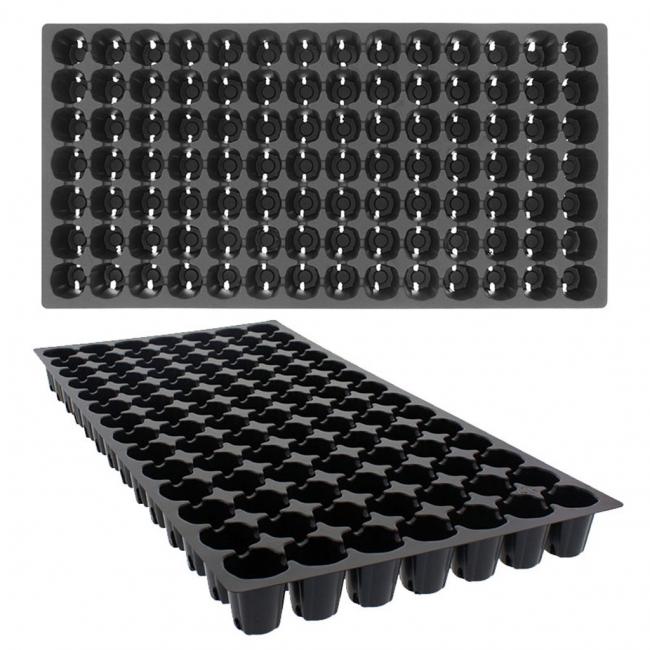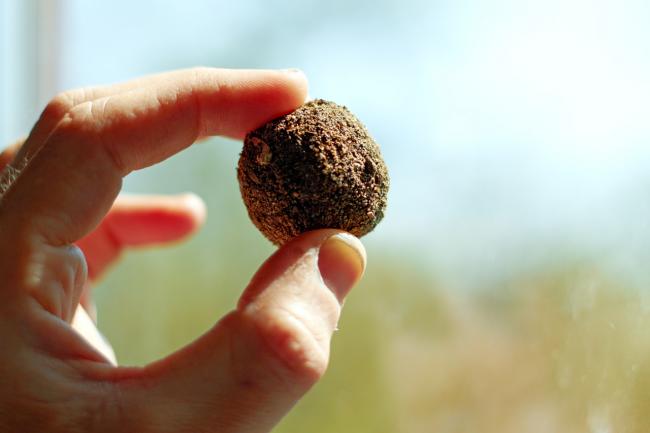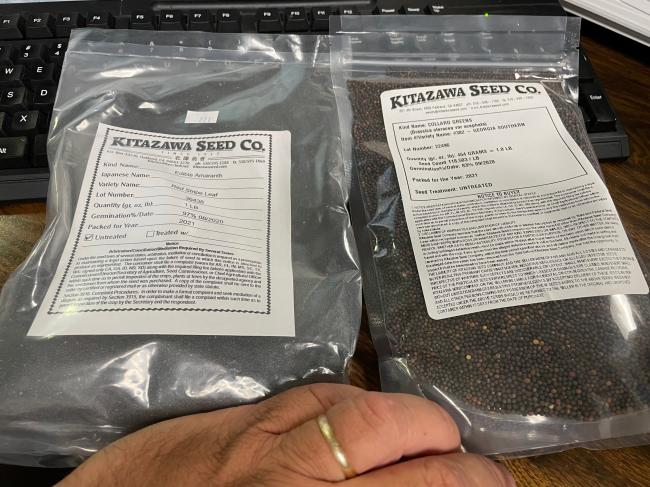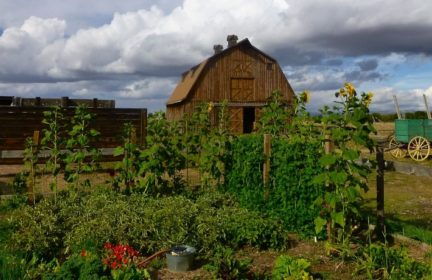Adventures in survival gardening: planting, sunstroke and flea beetle apocalypse – Edited to add frost and snow
Edit May 18: Pest now correctly identified as a flea beetle
Edit May 17: To add frost and snow – please refer bottom of post
Have you ever planned something to the very last detail and then had your project go completely sideways once you actually began executing the plan?
All winter I had poured over gardening information. I made lists. I made more lists. Then I organized my lists and began buying supplies. There has been increased interest in gardening due to Covid and I wanted to be ahead of potential shortages.
This was to be the year that I tested some of my ideas about survival gardening. How much food could I grow? Could I create a kind of secret survival garden in my yard? Would the idea of growing food plants among my flowers work?
I had spent last Friday and Saturday driving to two cities to collect bedding plants, six more 60 lb bags of soil and seven bags of assorted compost. My steel drive in posts and deer fencing had arrived. There were other garden supplies and all of it was neatly arranged inside my house. I managed to carve a path from my living room and the den to the rest of the house.
Did I mention that my husband is tearing apart the garden shed this year? He is redoing the shed storage he constructed last year. The shed was originally purchased for outdoor maintenance and tool storage. He now seems to consider it his workshop.
Last year it was below freezing before he finished his shed storage projects.
This means that this year everything is torn apart again and there is no room for garden supplies. I am also slowly inheriting odd automotive parts and snow shovels that were supposed to be housed inside that garden shed.
Despite the inside of my home looking like a retail garden centre, I was determined to learn and enjoy every moment of the gardening to come.
I had pre-arranged my bedding plants into groups for the planters and pots. They were lined up on foil pans ready to grab and go.
This past Wednesday, the weather finally turned and out I went to plant the three foot wide new planters on the North side. It was a slightly overcast day and nice for working outside.
I transplanted the bedding plants in the first and second North side planters without a problem. Then I hit the third planter and noticed these tiny bugs on my nice new white planters and trellis.
They were tiny, dark, fast, and jumped about very quickly. And, there were a lot of them. On the other side of my new planters is the neighbor’s brick outlined crushed rock bed with a few low evergreen shrubs planted in it. I had no idea where these bugs had come from or what they were.
I called my husband to look and he hadn’t seen anything like them either. He ran to the store to buy bug spray just in case. I kept planting and finished the seven planters, watered them and hosed off the bugs. I sprayed them all with bug spray to be on the safe side.
From there I went over to plant the thirteen front stoop planters and discovered that these tiny bugs were there as well. The bricks and lawn furniture were black with them.
Every planter had multiple marigolds as a deterrent for aphids. I also planted a lot of geraniums. Keeping ants away from the house and flowers usually keeps aphids at bay. These bugs didn’t look like aphids I had seen.
I finished planting, repeated the watering, hosing and bug spray and discovered I had been outside for seven hours straight.
The next day, I had to take my dog to the vet and pick up her heartworm medication for the year.
In the morning I checked my security cameras and discovered that my front stoop plants didn’t look right. I rolled back the footage and found the culprit. A single doe, very pregnant, had daintily nibbled her way through six geraniums, alyssum and lobelia. She actually climbed my brick stairs to do it.
Luckily, I had fencing stakes on hand for fast barriers and created a six strand deer fence with fishing line before I left for the vet.
While my dog was at the vet, I managed to pick up replacement plants and headed back home.
As the day went on, I was feeling more unwell. There was no fever, but I was in a cold sweat and really dehydrated. My husband has his industrial first aid and other training. My hair was up and he noticed the back of my neck. “You’re sunburned.” I told him I was wearing sun screen. “Did you wear a hat?”
Um. No. I planned to wear a hat, but my big sun hat wouldn’t fit over the hair comb that was holding up my hair. It was overcast and I was excited to get outside and start work, and yes I’m the idiot who didn’t wear a hat.
My husband got two cold towels for my head and back of my neck. “You have minor sunstroke because you didn’t wear a hat.” “Overcast days are the worst for sunstroke.” “Next time wear a hat.”
Note to all prepping gardeners: wear a hat. Sunstroke really creeps up on you.
The next morning I felt a bit better than the night before and decided to work in the shade by my back door. I planted five ten gallon pails of assorted kinds of tomato seed and three smaller pails of Genovese basil seed. These pails were neatly lined up on the rock around the sunny South side of my house.
I covered the pails with plastic wrap to create a greenhouse effect and hopefully sprout them faster. I left a bit of a gap for air flow.
The raised beds couldn’t be planted until I finished my garden tags for the seeds. I still wasn’t feeling all that great, so I decided to work indoors on that project and do a last minute check and revision on companion planting for the vegetables and herbs.
I took a break to check the front yard plants and discovered that they were swarming with those little tiny bugs. They were so thick, that they now looked like moving black sand. I sprayed everything again. There were more dead plants.
Now I was really concerned about the vegetables that were going to be growing in the raised beds.
Saturday morning came and I checked again and the bugs were everywhere. I moved supplies around in my den so I could get to the computer and searched.
I found a photo that could have been one of my plants. Sure enough, they are aphids. I had never seen newly hatched aphids before. I checked the front stoop and there were dead bugs all over the stoop. This meant that the insecticide my husband brought home had worked, but there were more of them. I sent him back to the store for more of it. They only had one bottle left, so we weren’t the only ones with a problem.
I don’t like using insecticides, but this is way beyond what hosing them off can control. I used a fine textured garlic powder and sprinkled that over the planter soil and plants. I couldn’t get it underneath the leaves very well, but I am hoping it will help to save what is left of my bedding plants.
I have never seen aphids in this number before, here or anywhere else. It is frightening considering the damage that they can do. It is one thing to lose flowers, but my real concern is their effect upon the food crops I plan to grow.
I have ornamental bedding plants, but the gardening is mainly about food production for survival and prepping. In the years I lived on a farm and gardened, we never had anything like this happen.
There is a difference in geography. When I lived on a farm, in an area near Lake Manitoba, there was pasture, bush and trees and some smaller fields. There was a mix of agriculture, such as dairy, mixed farming, and beef producers. Where I currently live, there are massive open treeless tracts of fields for the huge grain farms.
Trees and bush hold moisture. We had more snow and more rainfall where I used to live.
I have been racking my brain since yesterday trying to figure out what is happening.
This is a very dry year for us here. We didn’t have much snow pack last winter. The local agriculture is in trouble and they are talking drought. One community about an hour away has no potable water and is on water rationing. Their water comes from a man made lake.
Our natural lake is about five feet down and I could smell algae on the lake yesterday.
There doesn’t seem to be more ants, but I noticed that there aren’t any ladybugs.
Several years ago, Southern Manitoba had a problem with imported Asian ladybugs that had been brought in to control aphids. These ladybugs are not like our native ladybugs. The Asian ones bite. They became very invasive, swarming and intruding inside homes.
I am wondering if they are displacing the native ladybugs and plan to do some reading to find out more. I want native ladybugs and won’t order imported ones.
This is a huge infestation of aphids and they are killing plants rapidly. The way they are killing the plants doesn’t look like normal aphid damage. The plant is swarmed and literally collapses, shrivelled up and dead with some holes in the leaves.
Usually aphids will suck the leaves, which turn yellow and sometimes leave a black mould. Perhaps it is the life cycle that the aphids are at that is causing this different kind of damage?
As of this writing, I plan to go ahead with seeding, but am now scrambling to figure out how to protect the food crops first.
I am also concerned about how our climate is changing and the effects upon our food crops by predator insects. If a single winter of reduced snow pack and one dry spring can produce drought conditions that can impact predator insects this quickly, then there are some new things to consider in survival gardening.
If anyone has any ideas or suggestions, or has ever encountered this type of situation with aphids, please help.
Also, has anyone else noticed such a dramatic change in their gardening or environment after one season of reduced snow or rainfall?
I am going to continue searching for information and will check back later after I get some sleep.
May 17, 2021: I am typing this with one eye on the horizon and listening for the sound of thundering hooves. Another horseman comes riding, this one bears frost and snow.
Nope. There is no way to make what I have to communicate sound any better – I cannot **sassafrass**scoobie-do##double hockey sticks** believe this!!!
We are getting a low of 0 Friday and a low just above freezing the next day! Accompanied by, you guessed it: Rain! 15 mm of Rain! Plus some snow. It’s 30 degrees right now!
Do you know when I found this out? When I came indoors to get more seed. I planted more seed this morning and came in to find this out.
*Deep breath* I have had some time with a spoon and some ice cream to reflect and regroup.
This is a good lesson for preparedness. Usually people here don’t plant until after May long weekend, which is this coming weekend for us. Sometimes, people wait until the end of May.
This is on me. I made the decision to plant and seed now instead of waiting. I got taken in by the heat. Beware of fluke fluctuations in temperature.
My action plan to counter this news:
I have lots of plastic on a roll as part of my preps, so I am going to tent my flowers on the stoop and the flowers in 21′ of new planters, south side tomato and basil seeded pails, and the 4’x16′ planter that is seeded with lettuce, radishes, carrots, chives, peas and beans. It’s a long shot because seed needs a certain temperature to germinate. The plastic might give it a bit of a greenhouse effect.
I have starter soil and plenty of containers so I am going to start a bunch of plants inside, beans, tomatoes, etc. This will give me a chance to germinate the older vegetable seed to see if it is viable. I had planned to do this anyway as a survival garden experiment. If it works, I can keep some and give some to others who may have lost their vegetable seeds or plants in the frost.
The positive side:
I learned a really good lesson about gardening too early. I was too eager because last year I did wait until just after the traditional end of May planting and got nailed by low temperatures. I had to replant all my seed.
I learned not to get caught up in a stampeding herd of gardners. This year, stores were selling out of certain items. I had most of what I needed, but I got caught up in garden fever and started stampeding with the rest of the herd right out to the planters with my kneeling pad and bucket of seed.
This freezing spell may kill off those sassafrassing aphids.
I learned again to value having a huge roll of plastic on hand. I can’t count the times it has come in handy for emergencies.
Biggest lesson: Redneck is right: You can’t have enough seed. So many things can go wrong and today is a prime example of it. Even after our traditional planting times here, we have had snap freezing spells. Even one night is enough to kill plants and germinating seed.
What saved my neck is that I have extra vegetable seed on hand and plan to get more if it is available.
Thank you Redneck and please keep telling people to get extra seed, because nothing grows without seed.
I am going to catch up on the board, then get my supplies to start germinating seed indoors.
I think some Tom Petty is in order. “I won’t back down.” “You can stand me up at the gates of hell, but I won’t back down.”
Yeah, horseman, I can ride, too. Bring it.
-
Comments (21)
-





